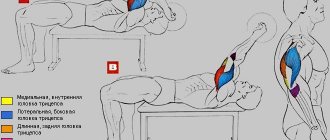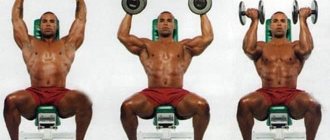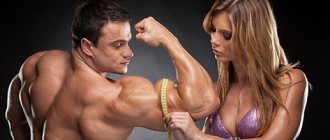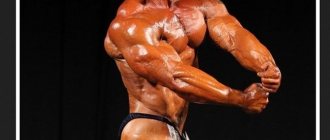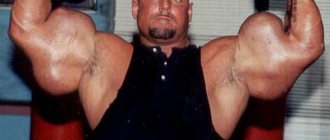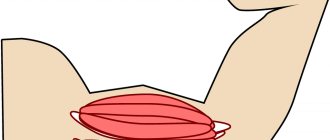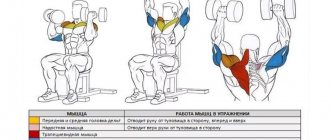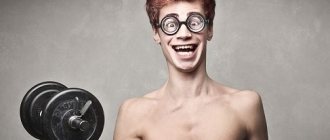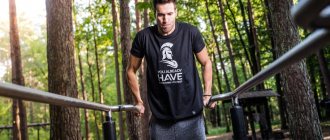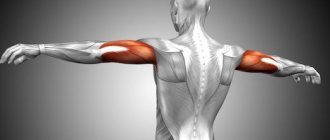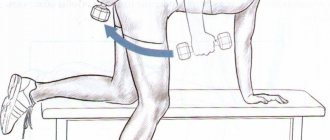Features (regime, nutrition, training)
This Arnold Schwarzenegger training program contains a large number of exercises. Whether you can train at this pace and whether it’s worth doing is up to you to decide.
Mode:
First stage:
- Monday: chest exercises, abdominal exercises, back exercises.
- Tuesday: shoulder exercises, upper and lower forearm exercises, abdominal exercises.
- Wednesday: hip exercises, calf exercises, lower back exercises, abdominal exercises.
- Thursday: chest exercises, back exercises, abdominal exercises.
- Friday: shoulder exercises, upper and lower forearm exercises, abdominal exercises.
- Saturday: hip exercises, calf exercises, lower back exercises, abdominal exercises.
In this program we do 5 approaches for each exercise . Each approach contains 10-14 exercises. If after each training session in such a program you still have a lot of strength left, then you need to move on to the second stage.
Second stage:
- Monday: chest exercises, abdominal exercises, back exercises, hip exercises, calf exercises.
- Tuesday: shoulder exercises, upper and lower forearm exercises, abdominal exercises, lower back exercises.
- Wednesday: hip exercises, calf exercises, chest exercises, abdominal exercises, back exercises.
- Thursday: lower back exercises, upper and lower forearms exercises, abdominal exercises, shoulder exercises.
- Friday: chest exercises, abdominal exercises, back exercises, hip exercises, calf exercises.
- Saturday: upper and lower forearms exercises, lower back exercises, abdominal exercises, shoulder exercises.
Nutrition and recovery tips:
- If you want to build quality muscle mass, eat 5-6 times a day
- Take gainer and protein immediately after training
- Eat a nutritious meal 30-60 minutes after training
- Rest at least 3 days a week
- Sleep 8-10 hours every day
- Take 30-50 grams of protein between meals
- Take unsaturated fats because... they are important for hormones and health
- Alternate beef, pork, chicken, fish
- Avoid sugar and sweets . Eat fruit instead
- If you have money for sports supplements, you can treat yourself to them, but keep in mind that they do not replace, but only complement natural food.
Previously, bodybuilding exercises and a bench press training program were reviewed.
Basic Arnold Arm Workout
This arm workout program lasts 30-40 minutes, depending on how much rest you take between sets. On average it should be 2 minutes, but everyone can vary it to suit themselves in the range from 1 to 3 minutes. You should train your arms according to this scheme no more than once a week. This scheme is not very intense and is suitable for any level of training. The main thing is to choose the right weight and do everything strictly technically.
| Exercise | Approaches | Repetitions |
| Barbell curl | 3 | 10 |
| Incline Dumbbell Curl | 2 | 10 |
| Concentrated biceps curl | 2 | 10 |
| Close grip bench press | 3 | 10 |
| Dips | 3 | 8-10 |
| Press to the bottom | 3 | 10 |
| Standing biceps curl with reverse grip | 3 | 10 |
| Barbell Wrist Curls | 3 | 12 |
Set of exercises
Exercise 1 - Hip Exercises
Technique for performing lunges with a barbell: You need to approach the Smith machine with your back and remove the barbell , placing it just below your shoulders, in the place where the barbell is usually located when performing squats. One leg should be in front, the other behind . After that, in this position, begin to perform squats with a barbell vertically, up and down.
Exercise 2 - Incline Dumbbell Press
Purpose of the exercise: Development of the middle and upper sections of the pectoral muscles . You can change the angle of the bench from almost horizontal to almost vertical; The greater the angle, the greater the load on the deltoid muscles. The recommended angle for training the pectoral muscles is 30-45 degrees. Execution: (A) Hold a dumbbell in each hand and lie down on an incline bench. Bend your elbows and hold dumbbells at shoulder height, palms facing up. (B) Simultaneously press the dumbbells overhead, then lower them to the starting position with your palms facing in front. Additionally, you can change the incline angle between workouts or between sets during the same workout session. In the latter case, it is preferable to start with a minimum angle and gradually increase it.
Exercise 3 - Raising the torso on a Roman chair
Raising your torso in a Roman chair works your upper abs. We sit in a Roman chair and lower our torso all the way down , then up (but not all the way, so that the abdominal muscles do not relax). This exercise is unique in that it allows you to lower your torso very deeply and stretch your abdominal muscles very effectively . Therefore, it is necessary to carry it out.
Exercise 4 - Pulldowns on a pulley device
Goal: widening the upper back muscles. This exercise should be performed on a block. Sit with your knees secured, grab the handle with a wide overhand grip , and pull down as low as possible. While not as effective as the wide grip pull-up movement, it has the advantage that you can use less resistance and therefore pull the handle much lower. Therefore, you work your lateralis muscles through a greater range of motion. You can pull to the chest (sternum) or to the back of the neck.
Exercise 5 – Seated Dumbbell Press
This exercise is designed to work the shoulder girdle muscles in addition to barbell presses or on its own. This is a basic movement for building mass, volume, and increasing the strength of the deltoid muscles, giving them a characteristic shape. The exercise can be performed while sitting on a regular bench, a bench with a supporting back (perhaps the best option), or even on a simple chair - the main thing is that it is firmly fixed and does not wobble. Technique: select the necessary dumbbells, sit down, and lift them to the level of the collarbones, with your thumbs pointing outward, and your hands with the dumbbells slightly supinated (turned toward you). The spine is straight, the elbows are in the plane of the body. This is the starting position. As you inhale, use your deltoid muscles to lift your arms with the dumbbells up, making sure that they move only in the frontal plane and that your elbows do not lean back. Press the dumbbells in an arc, at the top point they almost touch each other, but not to the point of impact. The shoulders are raised, and the arms at the top should be partially bent at the elbows; do not straighten them completely. Having paused at the top point, begin to lower your hands down, moving in the opposite direction along the same trajectory. Then proceed to the next repetition.
Exercise 6 - Dumbbell Wrist Curl
The forearm muscles need to be taken very seriously. Because they are involved in almost all core exercises. Take dumbbells with an underhand grip. Kneel in front of the bench. Place your hands on the bench so that they are across it. Straighten your arms. Your wrists should be outside the bench, but the dumbbells should not touch the bench when performing the exercise ! Open your palms slightly. Then lower the dumbbells down, straightening your wrists. The forearm and torso itself should be motionless.
Exercise 7 - Seated calf extension
Sitting on the exercise machine. Press your hips tightly with support pads. Place the toes of the feet on a special stand, lowering the heels down: Inhale, tense the feet (plantar flexion), rising up onto the toes. At the end of the movement, exhale. This exercise primarily works the soleus muscles. At the top, this muscle is attached under the knee joint to the tibia and fibula bones, and at the bottom - the calcaneal (Achilles) tendon to the tubercle of the calcaneus. Flexing the feet relaxes the calf muscles , which are attached at the top to the knee joint, and at the bottom to the heel (Achilles) tendon. When extending the foot, the calf muscle tenses only slightly. For best results, perform this exercise in sets of 10-20 repetitions.
#1 Bench press
The barbell press has always been considered one of the best chest exercises. Arnie is no exception. But pay attention to the width of the grip: he often used a rather wide hand position . This is due to the fact that Arnold had rather long arms, and this technique helped to better emphasize the load on the pecs.
If you also have long arms, you can use a similar technique. there are several “buts” here : you must have good training experience, strong wrists, ideal technique and a spotter. And if this is your first time experimenting with such a grip, practice with light weights. Don't risk your health!
Arnold liked to perform the bench press in sets of 20 to 6 repetitions , starting with light weights and ending with heavier ones towards the end of the sets. Accordingly, at the beginning, more repetitions were done with less weight, then fewer with more.
Arnold assigned a special role to breathing . Powerful inhalations and exhalations during the exercise helped stabilize the body, stretch the chest and fill the blood, and with it the muscles, with oxygen.
Tips for doing exercises
- Do not take dumbbells that are too heavy , otherwise you may not be able to maintain your balance, and if the dumbbell moves incorrectly, it can pull your shoulder back and dislocate the shoulder joint.
- Do not move up and down sharply or jerkily, because any irregularities in movement (especially with heavy weights) can negatively affect the spine, the body’s natural shock absorber.
- When you create a training program, you must include rest days in it. When training intensely, you need to rest long enough to allow your body to recuperate and build new muscle mass. This requires healthy sleep (it is best to sleep 8 hours a day). This also means that you must establish a system of priorities.
- On weekends you should also rest. This doesn't mean you can't do any physical activity; You don’t have to lie in bed or sit in front of the TV.
#3 Dumbbell flyes
Arnold liked to “finish off” his pecs with this exercise at the end of his workout. According to him, the exercise helped to stretch the pecs and work out their inner part.
Arnie did the exercise paying special attention to breathing technique . Before lowering the dumbbells, he took a deep breath and, as he exhaled, raised them. This technique helped to further stretch the pectorals at the lowest point.
By the way, regarding the bottom point. Arnie always tried to lower the dumbbells as low as possible so that they were quite close to the floor.
At the top, Arnie tried not to touch the dumbbells, but to keep them one foot apart from each other , since further movement no longer activates the pecs, but at the same time requires strength, which makes it impossible to successfully complete the following repetitions.
Biography
After the release of the film Titanic, actor Arnold Vosloo was constantly asked if he starred in this film, confused because of his resemblance to Billy Zane. Therefore, when he was asked to take a photo, thinking that it was the guy from the sunken ship, he only chuckled in his heart, but did not refuse movie fans.
Billy Zane and Arnold Vosloo look alike
Arnold Vosloo's appearance allowed him to take the role of a villain in Hollywood. In any case, the actor was given the role of tough guys, and he coped with the task one hundred percent. But there was a time when Arnold, in his youth, played romantic heroes on the theater stage in his native Pretoria and did not even think that he would become famous throughout the world.
Arnold Schwarzenegger's accent at the very beginning of his career
Arnold Schwarzenegger is from Austria and his native language is German.
He moved to the USA at the age of 21, being a titled bodybuilder. Let's take 1970 as a starting point, in which Arnold's first film, Hercules in New York, was released. The bodybuilder’s English level is quite good, but the accent is simply terrible. Sometimes it seems like he just speaks German rather than English.
In fact, it was because of this that he was dubbed in the first film. Yes, yes, the Arnie character was simply re-voiced. In cinemas his real voice was not heard at all.
Let's look at some examples right away. Let's take an undubbed passage from Hercules and show the full power of the German accent on it:
By the way, you can listen to the correct American pronunciation of words in the ED Words application.
Grassing and percussive [r]
The sound [r] in German and French is pronounced with the throat. Actually, it is with this sound that students who learn German as a second language have the most problems.
And who is that monster, who looks as if he is from the kingdom of the underworld?
This is especially clearly heard in the word “monster”.
The correct American pronunciation is [mɑnstər]. Schwarzenegger pronounces it as [monstər] with a gravel [r]. There is basically no such sound in English, which is immediately audible in speech. The percussion [r] also often slips through - almost like in Russian. For example, in the word "present". In some phrases, Arnie tries to pronounce the correct [r], but the grazing slips through even in cases where the [r] sound in the word is not pronounced.
The letter "o" and sounds associated with it
This is a real problem, because Schwarzenegger pronounced words with the letter “o” any way he wanted, but not correctly.
In German, there are essentially only 2 options for how to pronounce the letter “o”: the short “o” and the long “o”. In English, everything is much more confusing.
- Underworld - [ˈʌndərˌwɜrld]. Schwarzenegger pronounces the [ɜ] sound in the manner of the German “ö” (as in the words können or öffnen). The closest sound would be the e sound in the word “baked.” Instead of [ɜ], [œ] appears.
- Gone - [gɒn]. Instead of an open sound closer to “a”, we get an accented “o” - just like in Russian (and German).
- Look - [lʊk]. German also has the sound [ʊ], but it is pronounced completely differently. If in English the pronunciation is similar to the Russian “luk”, then Schwartz produces “luk”. Which is strange in principle, because the [l] sound in German is always soft.
Accenting sibilants
German is full of sibilants, but in English they are not emphasized so much.
The sounds [ʃ] [tʃ] and [ʒ], which almost completely correspond to Russian [ш], [ч] and [ж], Arnie emphasized in the German manner. In words like “permission” the sibilants sound too harsh, which gives the impression that he is speaking German.
Confusion with th
The sounds [θ] and [ð], which represent the digraph "th", do not exist in German, so all Germans have difficulty with them.
Schwarzenegger included. But if most often [θ] and [ð] are replaced in speech with the hard [z], then Arnie used [d] instead.
Most likely, he did this by analogy with the sound of the German articles “das” and “die”. Because the words “the” and “that” sound very similar to them.
But even inside words, instead of [θ] and [ð], a hard [d] sounds.
It doesn't bother me. - I don't care.
Instead of [ˈbɑðər] we hear [ˈbɑdə]. And a similar situation is repeated with absolutely all sounds [θ] and [ð].
[V] instead of [w]
The sound [w] does not exist in German.
All words with the letter “w” are read using the sound [v]. Many Germans who learn English as a second language transfer this habit to English. In the words “was”, “what”, “where”, “worry” Arnie also uses [v] and not [w]. By the way, Germans also often use the sound [f] instead of [v], because in German the letter “v” is read as [f], but this mistake is quite rare in Schwarzenegger. Basically, only in long phrases.
"Ask Arnold." Complete Isolation. BODYBUILDING is more of an art than a sport
The artist is trying to expand his palette as much as possible. So we, bodybuilders, have an unprecedentedly large number of exercises in our arsenal. Someone estimated that Michelangelo made at least a billion strokes while painting the ceiling of the Sistine Chapel. I think the body of an Olympia winner requires no less repetitions, as precise and precise as the movements of a great artist. With all the variety of our exercises, they are all divided into two large groups. Basic exercises build mass, while isolating exercises polish the shape of the muscles.
Beginners usually focus on basic movements, and this is the right strategy. However, individual muscle areas and entire bundles inevitably lag behind during basic training. Harmony can only be restored with isolating movements.
BRIEFLY ABOUT THE ESSENCE Mass training requires heavy weights and a small number of repetitions. Such exercises load several joints and a large number of muscles serving the joints at once. The effect of the exercise is dispersed, and therefore the training weight must be critical. Otherwise, the numerous muscles participating in the movement simply will not receive the stimulating load.
Isolation movements load only one joint. Examples include dumbbell flyes (only the shoulder works) or leg extensions (only the knee works). One joint is not capable of taking on a serious load, and therefore in isolation exercises one inevitably has to use relatively light weights. To increase intensity, increase the number of repetitions. In isolation sets for the core mouse, do 10-12 repetitions and 12-15 repetitions when isolating the leg muscles.
At one time I was often asked the question: is it possible to use isolation movements to grow muscle mass? My answer is; not all exercises are suitable for this. Low rep flyes (6-8 reps) will require such heavy dumbbells that the exercise becomes too dangerous. But I often practiced biceps curls on a music stand and concentrated lifts in a 6-8 repetition mode. So are barbell pullovers.
How to use isolation movements? Various tactical solutions are possible here. You can save isolation work until the end of your workout. First, with maximum effort, you will do all the heavy basic exercises, and then start isolating movements. This is the most common training method.
I myself practiced a lesser-known option: I did basic movements in the first half of the day, and transferred isolation movements to the evening. It turned out that I trained the muscle twice a day, first with basic exercises, then with isolation exercises.
An equally effective training method is to perform these and other exercises on different days. There was a time when I trained each muscle group twice a week. (By the way, to this day I consider this method of building mass the best.) So, my first chest workout included bench press, dumbbell bench press and incline presses, and the second included flyes, crunches and crossovers. Ask what to do with your back? The back muscles also have isolation exercises: pullovers and straight-arm rows on the upper block.) Don’t look down on isolation exercises. Remember the main rule: the path to mass lies through basic movements, and the path to the top is through corrosive and painstaking isolation.
#5 Pullovers
Pullovers are not very popular today, but Arnie loved them very much. He believed that they helped expand the chest and stretch the pectoralis . The exercise was usually performed at the end of the workout.
Pullovers were usually performed in a lying position across a bench, with the dumbbell lowered behind the head. The number of repetitions in each set was quite large: from 15 to 20 .
In between exercises, Arnold liked to take deep breaths for 30 seconds, which helped to further stretch the pecs.
Arnold Schwarzeneggerchestpectoral
